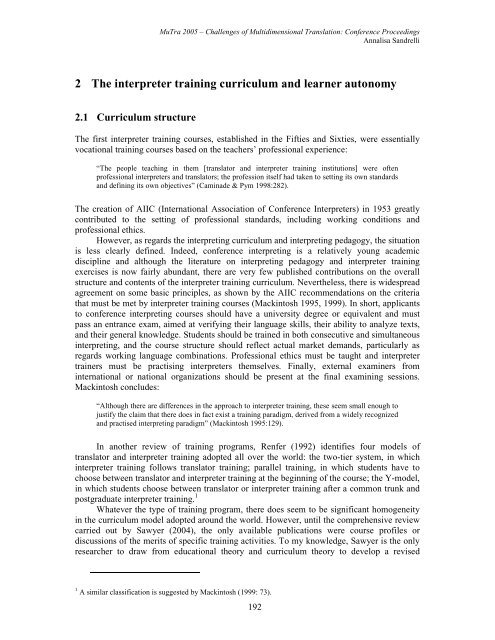Proceedings - Translation Concepts
Proceedings - Translation Concepts
Proceedings - Translation Concepts
You also want an ePaper? Increase the reach of your titles
YUMPU automatically turns print PDFs into web optimized ePapers that Google loves.
MuTra 2005 – Challenges of Multidimensional <strong>Translation</strong>: Conference <strong>Proceedings</strong><br />
Annalisa Sandrelli<br />
2 The interpreter training curriculum and learner autonomy<br />
2.1 Curriculum structure<br />
The first interpreter training courses, established in the Fifties and Sixties, were essentially<br />
vocational training courses based on the teachers’ professional experience:<br />
“The people teaching in them [translator and interpreter training institutions] were often<br />
professional interpreters and translators; the profession itself had taken to setting its own standards<br />
and defining its own objectives” (Caminade & Pym 1998:282).<br />
The creation of AIIC (International Association of Conference Interpreters) in 1953 greatly<br />
contributed to the setting of professional standards, including working conditions and<br />
professional ethics.<br />
However, as regards the interpreting curriculum and interpreting pedagogy, the situation<br />
is less clearly defined. Indeed, conference interpreting is a relatively young academic<br />
discipline and although the literature on interpreting pedagogy and interpreter training<br />
exercises is now fairly abundant, there are very few published contributions on the overall<br />
structure and contents of the interpreter training curriculum. Nevertheless, there is widespread<br />
agreement on some basic principles, as shown by the AIIC recommendations on the criteria<br />
that must be met by interpreter training courses (Mackintosh 1995, 1999). In short, applicants<br />
to conference interpreting courses should have a university degree or equivalent and must<br />
pass an entrance exam, aimed at verifying their language skills, their ability to analyze texts,<br />
and their general knowledge. Students should be trained in both consecutive and simultaneous<br />
interpreting, and the course structure should reflect actual market demands, particularly as<br />
regards working language combinations. Professional ethics must be taught and interpreter<br />
trainers must be practising interpreters themselves. Finally, external examiners from<br />
international or national organizations should be present at the final examining sessions.<br />
Mackintosh concludes:<br />
“Although there are differences in the approach to interpreter training, these seem small enough to<br />
justify the claim that there does in fact exist a training paradigm, derived from a widely recognized<br />
and practised interpreting paradigm” (Mackintosh 1995:129).<br />
In another review of training programs, Renfer (1992) identifies four models of<br />
translator and interpreter training adopted all over the world: the two-tier system, in which<br />
interpreter training follows translator training; parallel training, in which students have to<br />
choose between translator and interpreter training at the beginning of the course; the Y-model,<br />
in which students choose between translator or interpreter training after a common trunk and<br />
postgraduate interpreter training. 1<br />
Whatever the type of training program, there does seem to be significant homogeneity<br />
in the curriculum model adopted around the world. However, until the comprehensive review<br />
carried out by Sawyer (2004), the only available publications were course profiles or<br />
discussions of the merits of specific training activities. To my knowledge, Sawyer is the only<br />
researcher to draw from educational theory and curriculum theory to develop a revised<br />
1 A similar classification is suggested by Mackintosh (1999: 73).<br />
192
















